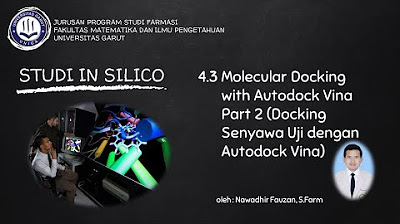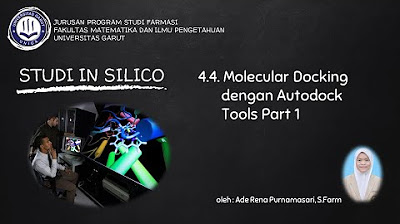Tutorial de Docking Molecular con Autodock : Proteina - Ligando
Summary
TLDRThis tutorial walks through the steps of performing molecular docking, specifically with the SARS-CoV-2 spike protein and a potential drug ligand. Using tools like MGL Tools, AutoDock, and a ligand database, the video explains how to download, prepare, and format protein and ligand structures. It covers setting up molecular interactions, creating a grid box for binding analysis, and running genetic algorithms to explore conformations. The output provides energy models for the most stable binding positions, demonstrating how this process can inform drug discovery and vaccine development.
Takeaways
- 🔬 The video is a practical guide for performing molecular docking, with a focus on using three programs: MGL Tools, Autodock, and Gpf.
- 💻 The tutorial uses the Spike protein of SARS-CoV-2 for the docking process, downloaded from the RCSB PDB database.
- 🧬 The Spike protein and human ACE2 receptor are highlighted as key structures in viral infection, and molecular docking can help in drug discovery and vaccine development.
- 📂 The ligand file is converted from .sif to .pdb format before being imported into the molecular docking software.
- 📉 The docking software generates models that predict the ligand’s interaction with the protein based on lowest energy conformations.
- 🧑🔬 Protein structure adjustments, such as adding polar hydrogens and correcting incomplete atoms, are performed before the docking process.
- 📦 Grid box setup is crucial, defining the spatial area where ligand and protein interactions will be calculated.
- ⚙️ A genetic algorithm is used for docking, with default parameters, allowing multiple iterations to find optimal ligand-protein interactions.
- 📊 Results of docking are analyzed using the output file, showing energy values and conformational models to determine the most stable binding sites.
- 💬 The presenter also mentions a Discord group for further Q&A sessions and hands-on workshops held every two weeks.
Q & A
What are the three molecular docking programs mentioned in the video?
-The three programs mentioned are MGL Tools, AutoDock, and Vina, all of which are essential tools for performing molecular docking experiments.
Why is the Spike protein of SARS-CoV-2 used in this docking tutorial?
-The Spike protein of SARS-CoV-2 is used because it was a key target during the COVID-19 pandemic for drug discovery and vaccine development. The docking aims to simulate how potential drugs or inhibitors could bind to the Spike protein and prevent the virus from infecting human cells.
What format is used to download the protein structure, and from which database?
-The protein structure is downloaded in PDB (Protein Data Bank) format from the RCSB (Research Collaboratory for Structural Bioinformatics) database.
What is the role of the ACE2 protein in relation to the Spike protein?
-The ACE2 protein is the human receptor that binds with the Spike protein of SARS-CoV-2, allowing the virus to attach to and infect human cells.
What should be considered when selecting the resolution of the protein for molecular docking?
-It is important to select a protein with a resolution lower than 2 angstroms for better accuracy in molecular docking simulations.
What is the purpose of converting the ligand file format to PDB in the docking process?
-The ligand must be converted from the CIF format to PDB format to ensure compatibility with molecular docking software, such as AutoDock, for proper interaction simulations with the protein.
What is the significance of adding hydrogen atoms during molecular docking preparation?
-Adding polar hydrogen atoms is crucial to ensure accurate modeling of hydrogen bonding interactions between the ligand and the protein during docking.
How is the grid box used in molecular docking, and why is it important?
-The grid box defines the spatial region where the interactions between the ligand and the receptor (protein) will occur. It helps to focus the docking calculations on the binding site and optimize computational resources.
Which specific atom sites are mentioned as key interaction points between the Spike protein and ACE2?
-The key interaction sites mentioned are atoms Q498, F41, and Q42. These atoms are involved in the interactions between the Spike protein and the ACE2 receptor.
What algorithm is used for the docking process, and why is it chosen?
-A genetic algorithm is used for the docking process, which is chosen for its efficiency in finding approximate solutions by mimicking evolutionary processes, making it suitable for complex molecular interactions.
Outlines

This section is available to paid users only. Please upgrade to access this part.
Upgrade NowMindmap

This section is available to paid users only. Please upgrade to access this part.
Upgrade NowKeywords

This section is available to paid users only. Please upgrade to access this part.
Upgrade NowHighlights

This section is available to paid users only. Please upgrade to access this part.
Upgrade NowTranscripts

This section is available to paid users only. Please upgrade to access this part.
Upgrade NowBrowse More Related Video

Cara Melakukan Molecular Docking antara Protein dengan Senyawa Alami Kandidat Obat

Molecular Docking Tutorial: AUTODOCK VINA - PART 2 | Beginners to Advanced

Tutorial Cara Gampang Melakukan Docking dengan PyRX, Vina Wizard

The lifecycle of SARS-CoV-2. Scientific version

4.3. Molecular Docking with Autodock Vina Part 2 (Docking Senyawa Uji dengan Autodock Vina)

4.4. Molecular Docking dengan Autodock Tools Part 1
5.0 / 5 (0 votes)